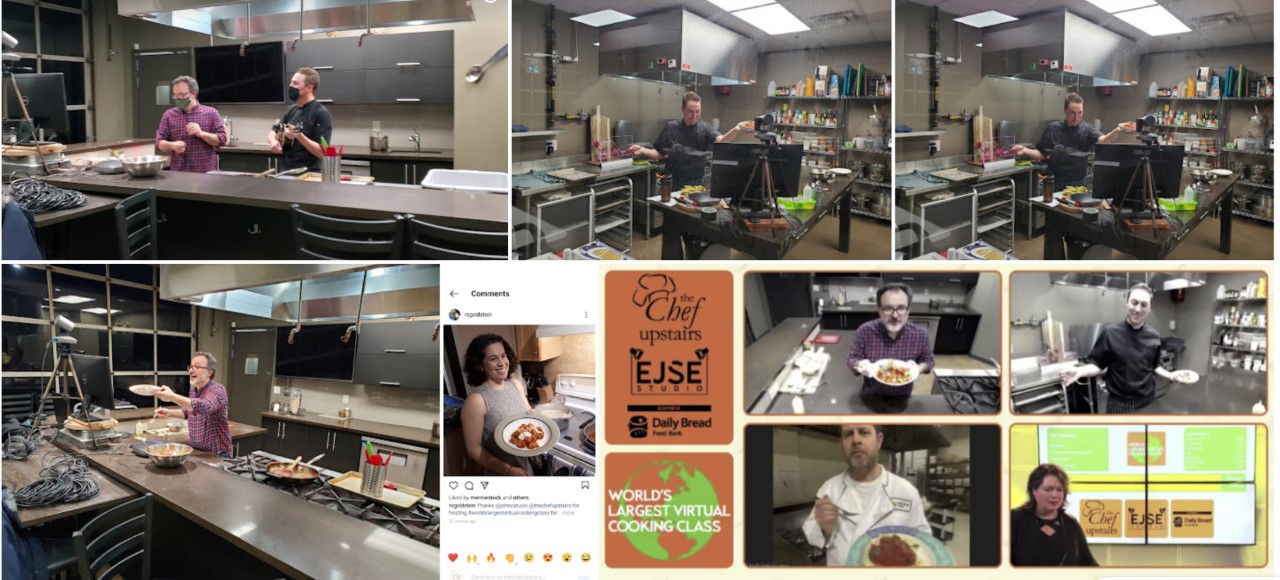By: Lalla Maiga
Did you notice any changes to your cooking and eating habits during a lockdown? To explore this question, Arlette Martinez, a Ph.D. student at Carleton University, cultural anthropologist, and former professional chef, conducted a research study among a group of adults engaging in online food activities to understand how our eating and cooking habits changed during the pandemic. At the Food Matters and Materialities conference, she discussed how Covid-19 provoked changes in terms of commensality and food sourcing practices.

Credits: Arlette Martinez.
Commensality, which means sharing a meal, is a quintessential social activity. People come together at the table to catch up and talk. With the onslaught of social distancing measures connected to the COVID-19 Pandemic, Martinez discovered that people began to engage in remote commensality – the act of sharing a meal while separated by a long distance. Moreover, research participants shared how they made food at Christmas dinner over Zoom, hosted bi-weekly dinners, and even joined virtual cooking classes hosted by professional chefs. People had adapted to the unusual situation they found themselves in and still managed to stay connected to make or share a meal. What has come from Martinez’s research study is that people tend to eat together still, regardless of the isolating tendency of COVID.
Martinez also observed changes in how people engaged in online food sourcing practices. She engaged in online food sourcing practices to recruit research participants for her study and observe practices in various online communities. In doing so, she discovered a wide array of online communities, from food-related Facebook groups to online community fridge groups, all of which emerged during the pandemic. Examples include the “Toronto COVID Cooking,’ ‘Quarantine Kitchen, ‘Ontario Mushroom Hunting’ Facebook group, and the ‘Community Fridges Hamilton Ontario’ group. Each group had its purpose: sharing recipes, grocery delivery promo codes, and cooking advice. In addition, community fridge groups facilitated access and collection of non-perishable food items.
There were also online food events in the shape of cultural centres. For instance, Martinez highlighted her attendance at the Japanese Canadian Cultural Center, which replicated their in-person activities of bento-making workshops by allowing attendees to pick up their personalized bento boxes. Martinez discovered that people were motivated to join these online groups to look up and exchange recipes, order and donate food. People also changed the way they got access to food. From UberEats to SkipTheDishes, to Instacart, people were ordering food and groceries right to their front step, with the click of a few buttons. But that also meant that local businesses suffered from the shutdowns and the changing behaviors of customers who grew used to ordering food online and not consuming it at their establishment.
Conversely, Martinez shows not everyone thrived being physically apart. Even though many people were staying connected through technologies, not everybody wanted to share a meal through a screen. Virtual cooking classes suffered from the dissatisfaction of not being able to physically taste or smell the food or instructors having to slow down the class to check the chat for any questions. The hidden difficulties of remote commensality Martinez identified were the smoke and mirrors of technology as the sole means of leisure social gatherings. As she put it herself, “it would be naïve to think everybody enjoyed cooking from home during isolation.”
With restrictions easing around the globe, Martinez continues to see people combing the virtual and in-person modes of sharing a meal. She remains interested in how, once again, people’s pandemic eating habits will change with the return to restaurants.